|
With the support of
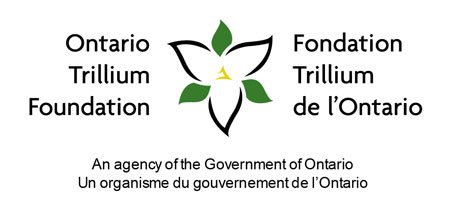
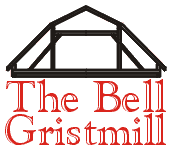

The
History of The Bell Mill
By Janet Panting, Heritage Histories
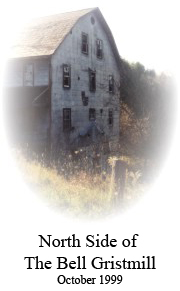 Mills offered important services in communities when water energy
was of great importance, prior to other sources of power. Because
of the water flow of Bear Creek, this mill, and Utopia, became
an important rural centre. The mill produced feed for the farmers
and flour which was distributed to the surrounding towns under
brand names: Gold Coin (for bread), Snowflake (for pastry),
Paracon xxx, and Bell's Best. The mill also made such grain
products as shorts (fine food for pigs), bran, and grits. Processed
grain from the western prairie provinces was shipped here by
train, then brought from the grain shed at the CNR siding, just
north of the mill, by horse and wagon and then often shipped
back west.
Mills offered important services in communities when water energy
was of great importance, prior to other sources of power. Because
of the water flow of Bear Creek, this mill, and Utopia, became
an important rural centre. The mill produced feed for the farmers
and flour which was distributed to the surrounding towns under
brand names: Gold Coin (for bread), Snowflake (for pastry),
Paracon xxx, and Bell's Best. The mill also made such grain
products as shorts (fine food for pigs), bran, and grits. Processed
grain from the western prairie provinces was shipped here by
train, then brought from the grain shed at the CNR siding, just
north of the mill, by horse and wagon and then often shipped
back west.
The
first gristmill on this site was built by James Spink in 1864, along
with a sawmill down-river. At the time when both mills were in operation,
it was necessary to run the gristmill at night and the sawmill during
the day because of insufficient water to operate both simultaneously.
In 1876, Richard Bell was hired to work in the mill, then in 1879, Richard
and his two brothers, John and Manuel, took over the operation of the
mill.
On
May 29, 1903, the Bell Mill went up in flames, the cause never determined.
The school bell was sounded as an alarm and the townspeople hurried
down to assist the Bell family, but the mill couldn't be saved. After
the fire, the neighbours grouped together at the scorched site to aid
in constructing a new mill. On New Year's Day of 1904, the new mill
was opened.
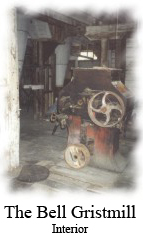 This new 3 storey mill was built with a solid foundation of stone
which is 4 ½ feet thick, and because of quicksand, the
new foundation had to be sunk very deeply. It is said that the
foundation is 30 feet deep. The stones for the foundation were
horse-drawn on wagons and all of the cement was mixed by hand.
The timbers were horse-drawn from a forest 8 kilometres away
then hand hewn and "framed" by Dave MacFarlane.
This new 3 storey mill was built with a solid foundation of stone
which is 4 ½ feet thick, and because of quicksand, the
new foundation had to be sunk very deeply. It is said that the
foundation is 30 feet deep. The stones for the foundation were
horse-drawn on wagons and all of the cement was mixed by hand.
The timbers were horse-drawn from a forest 8 kilometres away
then hand hewn and "framed" by Dave MacFarlane.
Richard
Bell's son, Harold, after serving overseas in World War I, went into
partnership with his father. Harold carried on the mill after his father's
death, and with the help of Gilbert McMaster, the mill continued to
operate as one of the most important businesses in the community. Mr.
McMaster worked there for approximately 30 years and remembered when
there would be twenty-five teams of horses and wagons lined up at the
mill with grain to be chopped.
The
survival of the smaller mills was being threatened; with competition
from the larger mills, a large number of farmers had their own choppers
now, and people were eating bread purchased from supermarkets. In the
late 1930s or early 1940s, the Bell Mill quit milling flour, providing
only gristmill services of chopping and mixing grain.
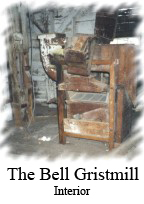 Hurricane Hazel changed the important role of the Bell Mill. On October
14, 1954, the hurricane raged, causing the creek to rise. The
water swept away the front porch of the mill and was several
feet deep on the first floor, flowing down the basement stairs
and out the other side. The quality and the strength of the
building is attested to by the fact that sustained little damage
and remains standing today. The hurricane washed the dam away
causing water to immediately recede from the mill. To rebuild
the dam would be too expensive, so Harold had a diesel engine
installed to power the mill.
Hurricane Hazel changed the important role of the Bell Mill. On October
14, 1954, the hurricane raged, causing the creek to rise. The
water swept away the front porch of the mill and was several
feet deep on the first floor, flowing down the basement stairs
and out the other side. The quality and the strength of the
building is attested to by the fact that sustained little damage
and remains standing today. The hurricane washed the dam away
causing water to immediately recede from the mill. To rebuild
the dam would be too expensive, so Harold had a diesel engine
installed to power the mill.
After
a year, the gristmill re-opened and now fertilizer was also sold. In
1965, the mill closed, having served the community for a century. Soon
after that, the Nottawasaga Valley Conservation Authority obtained the
mill and land for a water conservation project and recreational area.
In 1969, a new dam was complete.
The
mill now sits derelict, a mechanical jungle of belts, shafts, chutes
and pulleys, but this could change soon. Essa Township is entering into
a long-term lease with the NVCA, and along with citizens of the area,
plan to raise funds to restore the gristmill, making it fully operational.
A community centre is also planned for the property. The working mill
will offer the public, especially school children, the opportunity to
witness the milling process and to relive an important piece of a bygone
era.
For more information, please contact: Friends of the Utopia Gristmill & Park info@utopia.on.ca
|